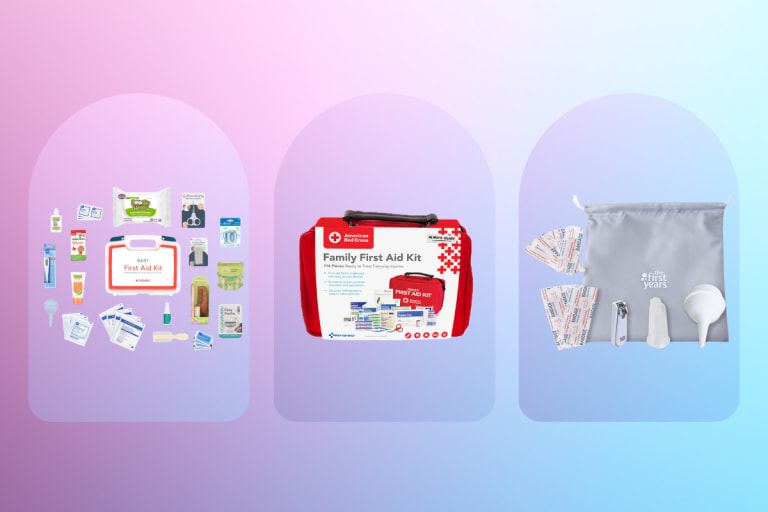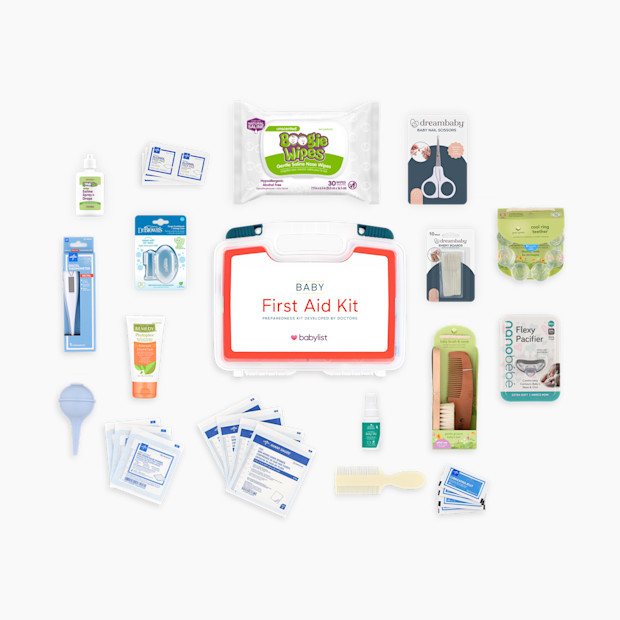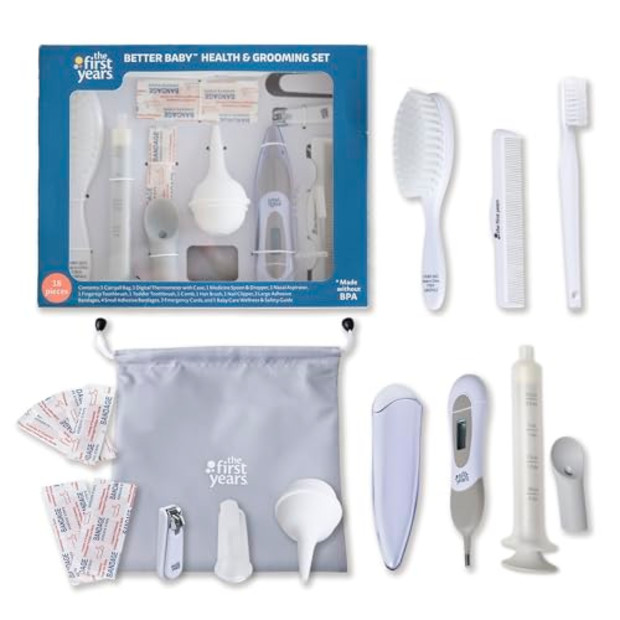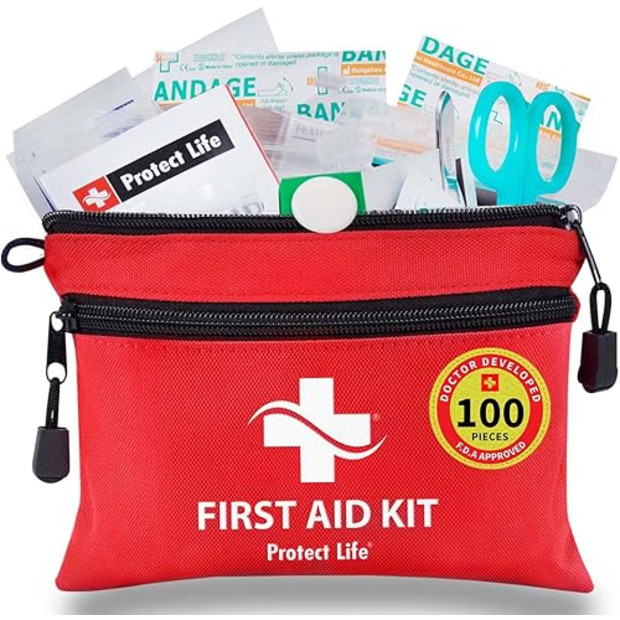
The Best First Aid Kits for Babies and Toddlers
Be ready for life’s little emergencies with these doctor-recommended first aid kits for both at home or on the go.

By Amylia Ryan and Jen LaBracio, CPST
Fact Checked by Shannon Vestal Robson
In This Article
Scraped knees, surprise fevers and late-night sniffles—life with babies and toddlers is full of little health hiccups. That’s why having a well-stocked first aid kit is a must for any parent or caregiver. Whether you’re at home or on the go, the right kit makes it easier to handle all the minor injuries and common illnesses that come with raising little ones.
The best baby and toddler first aid kits come pre-packed with everything you need, so you’re not scrambling in the moment. For babies, the Babylist Baby First Aid & Grooming Kit is our top pick—it includes both health and grooming basics like a digital rectal thermometer, nail clippers and a nasal aspirator, making it perfect for the first year. And for toddlers, the American Red Cross Deluxe Family First Aid Kit offers a wide range of medical supplies, from bandages to antibiotic ointment to a cold compress, all neatly organized in a portable case.
While many families love our top two picks for first aid kits, we also know that every family has different needs. So if these don’t feel like the perfect fit, we’ve included a few other great options on this list to consider. Whether you’re preparing for everyday bumps or just want to be ready when the sniffles hit, these are the best first aid kits to keep on hand for babies and toddlers.
Why Trust Babylist?
Babylist is the expert in baby; we know baby gear inside and out. We talk with parents face-to-face in our showroom and on our user panels and hear from thousands annually via our Best Baby Products online survey. We know what items millions of expecting parents are adding to their baby registries.
Firsthand professional and personal experience. As a Babylist editor and parent of two, I’ve spent 8+ years researching and testing baby products—including lots of first aid items. My two boys have had countless bumps, bruises and scrapes over the years, so I’ve really gotten to know first aid kits pretty well. Through both professional expertise and personal experience, I understand what first aid items work well for both babies and toddlers when it comes to soothing injuries and getting us through sick days.
Expert POV. When choosing a first aid kit, there are some safety things to keep in mind. For expert advice in this area, I consulted Dr. Seran Kim, a pediatric emergency physician and first aid kit expert, and Dr. Robert Quillin, a board-certified pediatrician and medical director.
First aid kit data. At Babylist, we regularly analyze the products our users are adding to their registries (and the products that they aren’t). Utilizing this data helps us narrow down the best first aid kits we should add to this guide.
Parent feedback and reviews. I also took into account hundreds of product reviews from parents who have used these first aid kits, so you can rest assured the products on this list are loved by parents and safe for babies and toddlers.
How We Judged the Best First Aid Kits
Best Overall First Aid Kit for Babies
You probably know how important it is for every family to have a first aid kit on hand, but it can be a little overwhelming to figure out what exactly should go into one—which is why we’ve taken care of it all for you. Babylist partnered directly with ER doctors to curate this exclusive Baby First Aid Kit that’s filled with hospital-grade medical supplies and soothers for baby’s first year and beyond.
It’s packed with full-sized items—one product reviewer said they were “very impressed by the quality”—plus info on how to use them. Babylist parents also love the included information cards on things like infant and toddler CPR, medication dosing and when to call 9-1-1: “ I love that when you open it up it has all kinds of medical treatments and recommendations,” says one product review.
Additional Specs
Includes: Gauze (2”x2” and 4”x4”), surgical lubricant, alcohol prep pads, digital rectal thermometer, Z-Guard Skin Protectant Paste, saline nasal spray & wipes, nasal bulb aspirator, pacifier, teething ring, silicone finger toothbrush, baby comb, wooden brush & comb set, baby oil, vitamin D drops, baby nail scissors and emery boards.
Best Overall First Aid Kit for Toddlers
This all-in-one kit is a great choice for families with toddlers (especially adventurous ones). Designed to cover everything from scraped knees to minor burns, it offers peace of mind for parents and caregivers. The soft-sided case is packed with 115 expert-recommended items, all organized for quick access in any minor emergency. Product reviews praise the case’s organized layout: “I love that this kit is like a binder with rings that make it easy to flip through the sections,” says a First Aid instructor in a product review. Other reviewers also love the large storage pouches and the included instructions for different First Aid situations—even CPR.
Including must-haves recommended by pediatricians as well as a few handy extras (it even comes with a CPR face shield), it’s an excellent solution for everyday toddler mishaps.
Additional Specs
Includes: Chewable aspirin tablets (81 mg each), triple antibiotic ointment packs (0.5g each), sting-free antiseptic cleansing wipes, hydrocortisone cream packs (1%, 0.9g each), hand sanitizer packs (0.9g each), trauma pads (5"x9"), gauze dressing pads (3”x3” and 4"x4"), conforming gauze roll bandage (3” and 4”), first aid tape roll, instant cold compress, CPR one-way valve face shield, emergency blanket, triangular sling/bandages, safety pins, adhesive plastic bandages (small and large), elbow and knee plastic bandages (small and large), knuckle and fingertip fabric bandages, disposable thermometers, tweezers, scissors, latex-free gloves, Red Cross Emergency First Aid Guide and nylon bag with clear pocket pages.
Best Affordable First Aid Kit
This 18-piece kit has everything you need—and some things you didn’t know you needed—to help get your baby through their first year. Can’t decide between fingernail clippers, scissors or an emery board? This kit has all three. While this kit is well stocked with many of the items pediatricians recommend, parents who have reviewed the product agree that the contents aren’t necessarily the highest quality, but they still get the job done). But at such a value price point, it makes a great baby first aid kit with the basics.
Additional Specs
Includes: Digital thermometer with case, medicine dispenser with spoon tip, nasal bulb aspirator, fingertip toothbrush, toddler toothbrush, comb, hair brush, nail clippers, adhesive bandages (large & small), emergency cards, baby wellness care & safety guide and drawstring carry bag.
Best First Aid Kit for Sick Days
Little Remedies New Baby Essentials Kit
From $19.99Specifically curated for the most common infant discomforts, this sample pack from Little Remedies provides gentle, safe relief to help little ones feel better. Whether your baby is congested, gassy, running a fever or just has some diaper rash, this compact kit has everything baby needs for a sick day—and all contents are free from artificial dyes and preservatives.
Parents love this kit because it’s “convenient” and packed with “effective” medicines that “helped get through the infant days.” Some product reviews also say that it’s a good kit to double up on, especially to take to grandparents’ or other caretakers’ houses. Packaged in a reusable travel bag, it’s ideal for home use or to keep in a diaper bag on the go.
Additional Specs
Includes: Little Remedies Saline Spray/Drops (0.5 fl oz), nasal aspirator, Little Remedies Gas Relief Drops (0.5 fl oz), Little Remedies Infant Fever & Pain Reliever (acetaminophen, 2 fl oz), Little Remedies Gripe Water (2 fl oz) and Boudreaux’s Butt Paste for Diaper Rash (2 fl oz).
Best Travel First Aid Kit
Compact, lightweight and TSA-friendly, the Protect Life Travel First Aid Kit is a parent favorite for treating minor injuries while on the move. Whether you’re camping, flying, road-tripping or just out for the day, this durable kit includes 100 essential first aid supplies to cover cuts, scrapes, splinters, blisters and more. The case is durable, water-resistant and smaller than a fanny pack, making it perfect for tossing in your diaper bag. Tons of product reviews say this kit is perfect for on-the-go, whether keeping in your car or, as one parent pointed out in her review, to “fix booboos at playgrounds.”
Additional Specs
Includes: First Aid Guide, emergency blanket, triangular bandage, first aid tape roll, tourniquet, conforming bandage, scissors, tweezers, moleskin blister pad, eye wash, adhesive bandages (small and large), knuckle and fingertip bandages, sterile gauze pads, antiseptic towelettes, prep pads (with iodine and without), safety pins, cotton-tipped applicators and a water-resistant case.
What to Look for In a Baby First Aid Kit
An infant-specific first aid kit resembles something like a healthcare-meets-grooming kit. You’ll want to have what you need to take care of both everyday tasks like nail clipping and hair brushing to illness symptoms like runny noses and fevers.
Must-Haves
According to Dr. Seran Kim, a pediatric emergency physician and first aid kit expert, the most important first aid kit contents include:
Nasal aspirator and saline drops to clear stuffy noses
Rectal thermometer with lubricant for accurate temperature readings
Infant acetaminophen with the corresponding medicine dropper for fever relief (only with a doctor’s approval for babies under two months)
Nail clippers and emery boards to prevent accidental scratches
Alcohol swabs for cleaning small scrapes
Zinc oxide diaper rash cream to treat and prevent irritation
Gum toothbrush to start early oral care
Nice-to-Haves
Dr. Kim says these items are optional but helpful additions:
Cradle cap brush
Gripe water or colic drops for digestive discomfort
Boogie saline wipes for gentle nose cleaning
Teething rings for soothing sore gums
Vitamin D drops, as recommended for breastfed infants
What NOT to Include
While the following items may be included in “complete” baby first aid kits, they’re not necessarily recommended. You might’ve noticed that bandages aren’t included in the lists above—Dr. Kim advises against including bandages in your baby’s first aid kit because they can pose a choking hazard as well as restrict circulation if wrapped too tightly. So what do you do if you need one? If possible, opt not to use one on minor cuts and scrapes (hold gauze until the bleeding stops). For larger cuts, seek medical attention.
Dr. Kim also advises parents to avoid using separate medicine droppers: “[They] should only be using droppers that come with associated medicine,” she says, so if your baby kit comes with an extra medicine dispenser, it’s best to take it out.
Additionally, Dr. Kim says to leave teething gels out of your baby’s first aid kit, since the American Academy of Pediatrics and the US Food and Drug Administration don’t recommend them. Many teething gels contain lidocaine or benzocaine, which can pose a serious health hazard to infants and toddlers.
How to Store a Baby First Aid Kit
Proper storage is key for both accessibility and ensuring the contents don’t expire or get damaged. A baby’s first aid kit should be kept somewhere that is easily accessible to adults but safely out of reach of little hands. “Common storage places are kitchens or bathrooms, but be sure that the cabinet is locked or placed high up,” says Dr. Kim. Dr. Robert Quillin, a board-certified pediatrician and medical director, also suggests that a first aid kit for a newborn might be stored in the baby nursery. Wherever you decide to put it, “be sure that the storage area is clean and dry, and not susceptible to extreme temperatures,” Dr. Kim says.
As far as the potency of any medicines, you likely won’t have to worry about anything expiring, Dr. Quillin says. “Most items have an extended shelf life. An infant is likely to outgrow the need for the items before the over-the-counter medications expire.” But if you end up keeping your first baby’s medicines for any younger siblings that might come along, you’ll need to check the expiration dates before your next baby arrives.
What to Look for in a Toddler & Family First Aid Kit
Eventually, babies turn into toddlers, and right around the time they start walking, it’ll be time to upgrade to a new first aid kit. "The first aid kit changes as the child goes through stages of development and activity,” Dr. Quillin says. "A first aid kit for a newborn will not be the same as a first aid kit for an older child.”
Dr. Kim emphasizes that at this point, parents can transition to a full-sized family first aid kit, which is useful for ages 1 through 100, she says.
Must-Haves
According to Dr. Kim and Dr. Quillin, a well-stocked, toddler-ready family kit should contain:
Various sizes of bandages
Sterile gauze
Non-adherent pads
Coban wrap
Burn dressings
Medical tape
Instant cold packs
Acetaminophen (like Tylenol)
Ibuprofen (like Motrin) for ages six months and up
Chewable aspirin (not for children under age 16 unless doctor-prescribed)
Diphenhydramine (like Benadryl)
Antihistamine (like Zyrtec or Allegra)
Antacid (like Pepcid or TUMS)
Antiseptic wipes
Antibiotic ointment
Eye shield
Sting relief pads
Hydrocortisone cream
Latex-free gloves
Forceps
Hand sanitizer
Nice-to-Haves
There are also useful extras to consider, Dr. Kim says, such as:
First aid shears
CPR face shield
Aluminum finger splint
Liquid bandages
Epinephrine auto-injector (if prescribed)
Narcan
Hydrocolloid gel bandages
CPR face shield
Laxatives
Anti-diarrheal medications
Detox wipes for poison ivy or oak exposure
Nexcare steristrips
Laceration wound closure bandages (like Zipstitch)
What NOT to Include
Though it may feel counterintuitive, Dr. Kim advises against using wound cleaning solutions: “Tap water has been shown to be just as or more effective at cleaning wounds,” she says. Similarly, Dr. Kim says that parents should avoid using burn creams in their first aid kits, as they can interfere with a physician’s ability to assess the severity of a burn.
How to Store a Family First Aid Kit
Because injuries can happen anywhere, it’s smart to keep first aid kits in multiple locations. Just like with baby first aid kits, it can be a good idea to store your family’s kit in the kitchen or bathroom—or even have multiple if you have a large house.
And don’t forget to stock a first aid kit in all of your toddler’s other frequently visited places, too. “Most first aid kits for families are appropriate for kids ages 1-100, so be sure to have one in each car, at grandparents’ houses or with other caregivers,” Dr. Kim says. Medications should always be kept out of reach of children, and parents should check their kits regularly to replace expired items.
Expert Sources
Babylist content uses high-quality subject matter experts to provide accurate and reliable information to our users. Sources for this story include:
Dr. Seran Kim, pediatric emergency physician and first aid kit expert
Dr. Robert Quillin, board-certified pediatrician and medical director




